

Konyak languages. Qiangic languages. Zeme languages. Kho-Bwa languages. Angami-Pochuri languages. Tamangic languages. West Himalayish languages. Karen languages. Lolo-Burmese languages. Tibetic languages. Tibeto-Burman languages. The Tibeto-Burman languages are the non-Sinitic members of the Sino-Tibetan language family, over 400 of which are spoken throughout the highlands of southeast Asia, as well as lowland areas in Burma (Myanmar). The name derives from the most widely spoken of these languages, namely Burmese (over 32 million speakers) and the Tibetic languages (over 8 million). Most of the other languages are spoken by much smaller communities, and many of them have not been described in detail. Some taxonomies divide Sino-Tibetan into Sinitic and Tibeto-Burman branches (e.g. Benedict, Matisoff). However, other scholars deny that Tibeto-Burman comprises a monophyletic group.
Burmese language. Burmese is spoken by 32 million as a first language and as a second language by 10 million, particularly ethnic minorities in Burma and those in neighboring countries.

(Although the Constitution of Burma officially recognizes the English name of the language as the Myanmar language,[3] most English speakers continue to refer to the language as Burmese.) Classification[edit] Tangut language. Tangut (also Xīxià or Hsi-Hsia or Mi-nia) is an ancient northeastern Tibeto-Burman language once spoken in the Western Xia Dynasty, also known as the Tangut Empire.
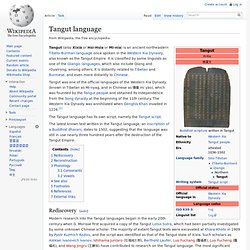
It is classified by some linguists as one of the Qiangic languages, which also include Qiang and rGyalrong, among others. It is distantly related to Tibetan and Burmese, and even more distantly to Chinese. Karbi language. The Karbí language, also known as Mikir or Arleng, is spoken by the Karbi people of Assam.
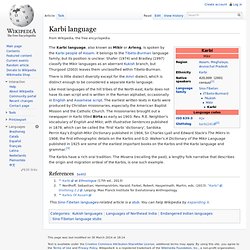
It belongs to the Tibeto-Burman language family, but its position is unclear. Shafer (1974) and Bradley (1997) classify the Mikir languages as an aberrant Kukish branch, but Thurgood (2003) leaves them unclassified within Tibeto-Burman. There is little dialect diversity except for the Amri dialect, which is distinct enough to be considered a separate Karbi language. Like most languages of the hill tribes of the North-east, Karbi does not have its own script and is written in the Roman alphabet, occasionally in English and Assamese script. The earliest written texts in Karbi were produced by Christian missionaries, especially the American Baptist Mission and the Catholic Church. The Karbis have a rich oral tradition. Tujia language. The Tujia language (Chinese: 土家语, pinyin: Tǔjiāyǔ) is a language spoken natively by the Tujia ethnicity in south-central China.
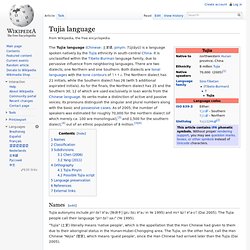
It is unclassified within the Tibeto-Burman language family, due to pervasive influence from neighboring languages. There are two dialects, one Northern and one Southern. Both dialects are tonal languages with the tone contours of ˥ ˥˧ ˧˥ ˨˩. The Northern dialect has 21 initials, while the Southern dialect has 26 (with 5 additional aspirated initials). Lhokpu language. Lhokpu, also Lhobikha or Taba-Damey-Bikha, is one of the autochthonous languages of Bhutan spoken by the Lhop people.
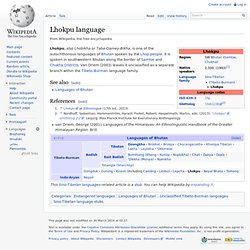
It is spoken in southwestern Bhutan along the border of Samtse and Chukha Districts. Van Driem (2003) leaves it unclassified as a separate branch within the Tibeto-Burman language family. See also[edit] Magaric languages. The Magaric languages are a small proposed family of Tibeto-Burman languages spoken in Nepal, notably including -- including Magar and Kham.
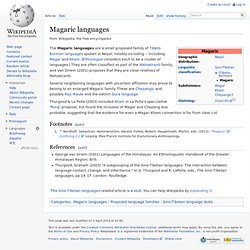
(Ethnologue considers each to be a cluster of languages.) They are often classified as part of the Mahakiranti family, and Van Driem (2001) proposes that they are close relatives of Mahakiranti. Several neighboring languages with uncertain affiliation may prove to belong to an enlarged Magaric family. These are Chepangic and possibly Raji–Raute and the extinct Dura language. Kham language. Kham (Nepali:खाम) (also Khamkura खामकुरा or Kamkura कामकुरा) -- narrowly defined—is a complex of Tibeto-Burman Magaric languages spoken natively in isolated highlands of Rolpa and Rukum districts of Rapti and the westernmost part of Baglung district in Dhaulagiri Zone by western clans of the Magar tribe, called collectively Kham Magar or Northern Magars.
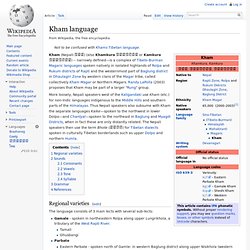
Randy LaPolla (2003) proposes that Kham may be part of a larger "Rung" group. More loosely, Nepali speakers west of the Kaligandaki use Kham (etc.) for non-Indic languages indigenous to the Middle Hills and southern parts of the Himalayas. Thus Nepali speakers also subsume with Kham the separate languages Kaike—spoken to the northwest in lower Dolpo—and Chantyal—spoken to the northeast in Baglung and Myagdi Districts, when in fact these are only distantly related.
The Nepali speakers then use the term Bhote (भोटे) for Tibetan dialects spoken in culturally Tibetan borderlands such as upper Dolpo and northern Humla. Sounds[edit] Tone[edit] Magar language. Not to be confused with the Magyar language, known in English as Hungarian Magar (Nepali: मगर भाषा Magar bhasa) is a language spoken mainly in Nepal, Southern Bhutan, Darjeeling, India, and Sikkim, India, by the Magar people.
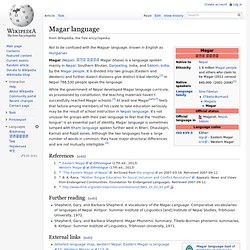
It is divided into two groups (Eastern and Western) and further dialect divisions give distinct tribal identity.[2] In Nepal 788,530 people speak the language. While the government of Nepal developed Magar language curricula, as provisioned by constitution, the teaching materials haven't successfully reached Magar schools.[3] At least one Magar[who?] Feels that failure among members of his caste to take education seriously may be the result of school instruction in Nepali language.
Ao languages. Pyu language (Burma) The Pyu language (Burmese: ပျူ ဘာသာ, IPA: [pjù bàðà]; also Tircul language) is an extinct Tibeto-Burman language, mainly spoken in present day central Burma (Myanmar) in the first millennium CE.
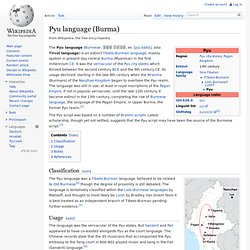
It was the vernacular of the Pyu city-states which thrived between the second century BCE and the 9th century CE. Hani language. The Hani language (Hani: Haqniqdoq or xa˧˩nʲi˧˩; simplified Chinese: 哈尼语; traditional Chinese: 哈尼語; pinyin: Hāníyǔ; Vietnamese: Tiếng Hà Nhì) is a language of the Loloish (Yi) branch of the Tibeto-Burman linguistic group spoken in China, Laos, and Vietnam by the Hani people.
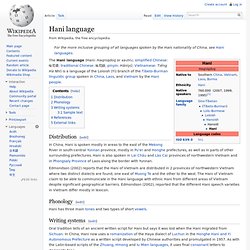
Distribution[edit] In China, Hani is spoken mostly in areas to the east of the Mekong River in south-central Yunnan province, mostly in Pu'er and Honghe prefectures, as well as in parts of other surrounding prefectures. Hani is also spoken in Lai Châu and Lào Cai provinces of northwestern Vietnam and in Phongsaly Province of Laos along the border with Yunnan. Edmondson (2002) reports that the Hani of Vietnam are distributed in 2 provinces of northwestern Vietnam where two distinct dialects are found, one east of Muong Te and the other to the west. The Hani of Vietnam claim to be able to communicate in the Hani language with ethnic Hani from different areas of Vietnam despite significant geographical barriers. Pai-lang language. Pai-lang (Chinese: 白狼; pinyin: Bái láng) is the earliest recorded Tibeto-Burman language, known from three short songs recorded in the "Treatise on the Southern Barbarians" chapter of the Book of Later Han, totalling 44 four-syllable lines.[1] The language is clearly either Lolo–Burmese or closely related, but as of the 1970s it presented "formidable problems of interpretation, which have been only partially solved".[2] According to the Book of Later Han, the songs were recorded in western Sichuan and a Chinese translation presented to Emperor Ming of Han (58–75 AD).
A Pai-lang version, transcribed elsewhere in Chinese characters, was interpolated when the book was compiled in the 5th century. Thus in addition to the distortion inherent in transcription, interpretation is complicated by the transmission history of the text and uncertainty about the pronunciation of Eastern Han Chinese.[3] References[edit] Jump up ^ Coblin, W. Jingpho language. Jingpho (Jinghpaw, Chingp'o), or Kachin (Burmese: ကချင်ဘာသာ [kətɕɪ̀ɴ bàðà]), is a Tibeto-Burman language mainly spoken in Kachin State, Burma (Myanmar) and Yunnan Province, China. The term Kachin language can refer either to the Jingpho language or to a group of languages spoken by various ethnic groups in the same region as Jingpo: Lisu, Lachit, Rawang, Zaiwa, Lhaovo, Achang (Ngo Chang), and Jingpho.
These languages are from distinct branches of the highest level of the Tibeto-Burman family. The ethnic Jingpho (or Kachin) are the primary speakers of Jingpho language, numbering approximately 900,000 speakers.[2] The Turung of Assam in India speak a Jingpho dialect, called Singpho, mixed with Assamese words. The Jingpho alphabet is based on the Latin script. Jingpho has verbal morphology that marks the subject and the direct object. Jingpho syllable finals can consist of vowels, nasals, or oral stops. Tonal[edit] Raji–Raute languages. The poorly documented and closely related languages Raji, Raute, and apparently Rawat are spoken by hunter-gatherers in the Nepali Terai.
The three languages are spoken by in the Karnali and Kali river watersheds of western Nepal, and in the border states of Uttarakhand and Udam Singh Nagpur in India. Their relationship within the Tibeto-Burman languages is unclear. A database of 700 items from households of Raute and Ban Rawat speakers (Fortier 2012) indicates a largely Tibeto-Burman language ancestry. Deep Root[clarification needed] items include 58 words of Sino-Tibetan origin and 7 of Austroasiatic origin. Raute language. Raji language. Raji is a small Tibeto-Burman language of Nepal.
Speakers were recently nomadic. Distribution[edit] According to Ethnologue, Raji is spoken in the following areas of Nepal. Bheri Zone: Surkhet, Banke and Bardiya districtsSeti Zone: Kailali districtMahakali Zone: Kanchanpur district References[edit] Naxi language. Lisu language. Lisu (Lisu: ꓡꓲ-ꓢꓴ or ꓡꓲꓢꓴ; Burmese: လီဆူ ဘာသာစကား, pronounced: [lìsʰú bàðà zəɡá]) is a tonal Tibeto-Burman language spoken in Yunnan (southwestern China), northern Burma (Myanmar), and Thailand and a small part of India.
Lepcha language. Hruso languages. Hruso language. Miji language. Miji, also Dhammai or Sajalong, is a small language cluster of possibly Tibeto-Burman languages in Arunachal Pradesh, northeastern India. "Dialects" include at least two distinct languages, which are not particularly close, given only half of the vocabulary in common between the dialects of East Kameng District and West Kameng District.
Long assumed to be a Tibeto-Burman language, it may actually be a language isolate.[5] Dura language. Lahu language. Lahu (autonym: lɑ˥˧xo˩) is a Tibeto-Burman language spoken by the Lahu people of China, Thailand, Myanmar, and Laos. It is widely used in China, both by Lahu people, and by other ethnic minorities in Yunnan, who use it as a lingua franca.[2] However, the language is not widely used nor taught in any schools in Thailand, where many Lahu are in fact refugees and illegal immigrants, having crossed into Thailand from Myanmar.[3] Dialects[edit] A few dialects are noted, which are each known by a variety of names:[4]
Yi people. Dhimal languages. Dhimal language. Toto language.
Kukish languages. Tangkhul languages. Tamang language. Selected ethnic groups of Nepal; Bhotia, Sherpa, Thakali, Gurung, Kirant, Rai, Limbu, Nepal Bhasa, Pahari, Tamang Tamang (Devnagari: तामाङ; tāmāng) is a term used to collectively refer to a dialect cluster spoken mainly in Nepal, Sikkim, West Bengal (Mainly Darjeeling Districts - पश्चिम बङ्गाल राज्यको दार्जीलिङ जिल्लाको बिभिन्न भूभाग), Some Parts Of Assam and North East Region. It comprises Eastern Tamang, Northwestern Tamang, Southwestern Tamang, Eastern Gorkha Tamang, and Western Tamang. Lexical similarity between Eastern Tamang (which is regarded as the most prominent) and other Tamang languages varies between 81% to 63%; lexical similarity between Spanish and Portuguese, for instance, is estimated at 89%[citation needed].
Dialects[edit] Bai language. Chepangic languages. Chepang language. Bhujel language. 'Ole language. Naxi language. Digaro languages. Digaro Mishmi language. Idu Mishmi language. Tshangla language. Akha language. Midzu languages. Miju language. Zakhring language. Mru language. Nepal Bhasa. Meitei language. Gongduk language. Siangic languages. Milang language. Koro language (India)